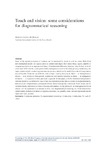Touch and vision: some considerations for diagrammatical reasonning

Ver/
Use este enlace para citar
http://hdl.handle.net/2183/13419Coleccións
Metadatos
Mostrar o rexistro completo do ítemTítulo
Touch and vision: some considerations for diagrammatical reasonningAutor(es)
Data
2012Cita bibliográfica
Culture of communication / Communication of culture, 2012: 1297-1306. ISBN: 978-84-9749-522-6
Resumo
[Abstract] Some of the spatial properties of surfaces can be translated by touch as well as vision. Both blind and clearsighted people can equally perceive corners and edges; their minds being equally capable of recognizing objects or arrangements of these. A fundamental difference, however, must be kept in mind: while most of the time the visual system readily homogenizes sensitive data through unity constructing, the haptic system usually «makes experiments» across time, which can be unified by a rule of interpretation only afterwards. Those are two different kinds of logic: visually knowing an object — or arrangement of objects — is to perceive it from general to particular, and tactilely knowing an object — or arrangement of objects — is to perceive it from particular to general. In this paper, with the theoretical background of peircean semiotics, we address the issue of how touch [predominantly inductive] and vision [predominantly deductive] are complementary perceptual/critical senses ecologically connected. Such senses can be intersemiotically translated, as outline drawings demonstrate. A map produced for clearsighted and blind persons will be examined in an attempt to show how diagrammatical reasoning can be developed from predominantly deductive or inductive cognitive processes, and possibly share common representations for haptic and visual systems.
ISBN
978-84-9749-522-6





